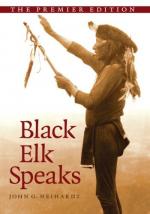|
This section contains 556 words (approx. 2 pages at 400 words per page) |

|
Black Elk Speaks Summary & Study Guide Description
Black Elk Speaks Summary & Study Guide includes comprehensive information and analysis to help you understand the book. This study guide contains the following sections:
This detailed literature summary also contains Bibliography on Black Elk Speaks by John Neihardt.
Black Elk Speaks (1932) is the story of an Oglala Sioux medicine man who lived with his people on the Great Plains through most of the second half of the nineteenth century—an age that saw many bloody conflicts between American Indians and white soldiers and settlers. As a child, Black Elk experienced a vision that he thought would help lead his people through the hardships they were just beginning to endure. Unfortunately, Black Elk's story is ultimately one of broken dreams and unfulfilled visions. Like so many other tribes, the Oglala Sioux's traditional way of life ran counter to the American dream as envisioned by most white Americans in the nineteenth century.
Black Elk Speaks, by John G. Neihardt, is one of the most unusual memoirs ever put to paper. Black Elk, the Oglala Sioux medicine man whose life the book relates, did not speak English. John G. Neihardt, the poet and authority on Plains Indian culture who brought Black Elk's tale to the page, did not speak Sioux. However, the two men recognized each other as kindred spirits, and each played an important part in bringing the book to life.
Neihardt first traveled to meet Black Elk while researching the ghost dance movement of the 1890s for an epic poem he was writing. Hearing that Black Elk had been an instrumental participant in the Oglala ghost dance movement, Neihardt hoped to glean some firsthand information for his poem. After first meeting the aging medicine man, however, Neihardt felt that Black Elk's story was an important piece of American history in its own right that needed to be preserved:
As hunter, warrior, practicing holy man, and indubitable seer, he seemed even then to represent the consciousness of the Plains Indian more fully than any other I had ever known; and when I became well acquainted with his inner world, I knew this to be true.
The two men relied on their children to complete their task: Black Elk's son translated his father's words into English, while Neihardt's daughter recorded a stenographic transcript of the translation. Neihardt later pieced together the transcript, rewriting portions to capture the flavor and meaning of Black Elk's original spoken testimony and to maintain narrative flow. This has led to some criticism that the book is not an autobiography, because many of the specific phrases and sentences in the book originated not with Black Elk, but with his son and with Neihardt. Vine Deloria Jr. in his foreword to the book, argues that such criticism misses the point: "The very nature of great religious teachings is that they encompass everyone who understands them and personalities become indistinguishable from the transcendent truth that is expressed."
Although the book fell into relative obscurity for nearly three decades after it first appeared, a renewed interest in American Indian heritage among readers led to new editions of Black Elk Speaks to be published in 1961, 1972, and 1979. More recent editions contain supplemental materials and accounts that help place the creation of Black Elk Speaks in a richer historical and literary context. The book remains an essential text for anyone seeking to understand and appreciate the practices and beliefs of the Lakota Sioux, as well as anyone hoping to gain a fuller understanding of the consequences of the westward expansion of the United States in the 1800s.
Read more from the Study Guide
|
This section contains 556 words (approx. 2 pages at 400 words per page) |

|



